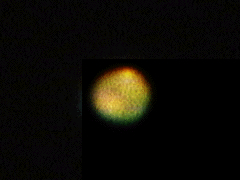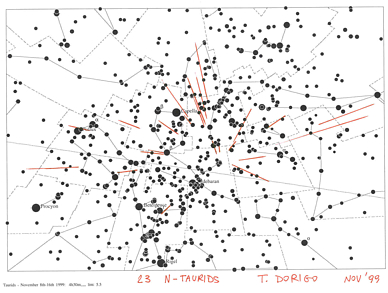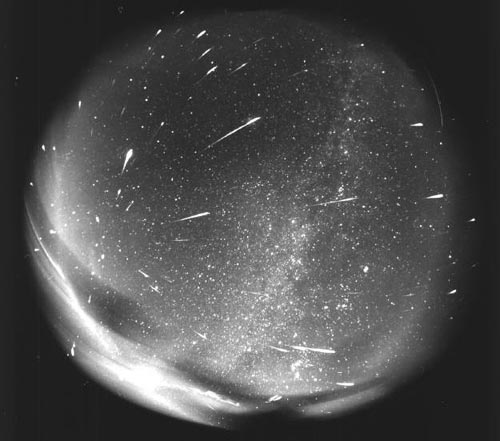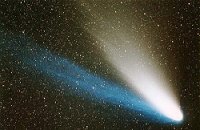Astronomy
I've always been an amateur astronomer. My main interests are
planet observation (with my self-built 8" newtonian, later
joined by a 6" Maksutov-Cassegrain), particularly
Jupiter and Saturn, and meteor shower studies. Lately I have only been
looking at meteor showers occasionally, but whenever I do it I always send
my observations to
Dr. Enrico Stomeo, the organizer of the
meteor shower
group of the
UAI (Unione Astrofili Italiani).

|
|
Stack of 6 frames of Mars, taken on Aug 31 2003 |
NEW!
Mars reached opposition on August 27th, 2003. I observed it
at 240x with the 6" Maksutov from my balcony on August 31st,
and got a glimpse of its south polar cap and a few other details of the
surface. The seeing was fair, with a resolution of 3 to 4 arcseconds.
On this picture you can more or less see how the disk looked like
(stack of 6 frames taken with a digital camcorder).
The 2002 Leonids have performed a great
show in the night of November 19th, with a ZHR close to 3500 for
observers in Europe (a second peak visible in the Americas also
yielded roughly 3500 meteors/hr). I observed from the Argentario (GR)
in Italy, and saw more than 250 meteors despite intermittent clouds
and the full moon. I also recorded 120 tracks on a camcorder. You
can get a few clips here:
 MPG clip, 1Mb:
two bright tracks (a short one of Mv=-2.5 with a trail lingering on for
1 second, the other of Mv=0)
appear northwest of Leo in the matter of two seconds!
MPG clip, 1Mb:
two bright tracks (a short one of Mv=-2.5 with a trail lingering on for
1 second, the other of Mv=0)
appear northwest of Leo in the matter of two seconds!
 MPG clip, 1Mb:
a moon-class fireball (out of the field) yields a bright flare,
followed by three more zero-magnitude tracks in Orion in the matter of
7 seconds!
MPG clip, 1Mb:
a moon-class fireball (out of the field) yields a bright flare,
followed by three more zero-magnitude tracks in Orion in the matter of
7 seconds!
 MPG clip, 0.3Mb:
a Mv=+1 track in Orion is followed by a Mv=0 track perfectly aligned with
the former in one second.
MPG clip, 0.3Mb:
a Mv=+1 track in Orion is followed by a Mv=0 track perfectly aligned with
the former in one second.
 |
|
Star chart showing the 23 meteor tracks |
Here is a recent and typical meteor observation report chart
(well, not so typical, one of my best-looking ones!):
a summary report on 23 North-Taurids observed between
November 8th and 16th, 1999. The red tracks are meteors associated to
the active radiant; I've not pictured the other observed meteors (41
more during a total observation time of 12 hours and 45
minutes) to have a clearer picture of the northern taurids.
 |
|
More than 100 tracks of meteors brighter than Mv=+2 are
recorded in this 3-hour image |
On the night of November 17th, 1998 a fantastic display of Leonid meteors
was on. Rates at the peak were around 300 meteors per hour, therefore
not extremely unusual; what was special was the very large amount of bright
meteors and fireballs. The image on the right gives a pretty clear idea of
what could be observed on that night.
Nevertheless, this year's display definitely outshined last year's.
Less fireballs and bright meteors, but a
13 times higher count at the peak. Those lucky observers that were able
to look at the sky during the peak time, at around 2.03 UT on
Nov. 18th, were dazzled by rates of about a meteor per second!
You can check it out on
the preliminary ZHR plot issued by the
International Meteor Organization.
This other plot , also provided by the IMO,
is the highest resolution ZHR distribution ever
obtained for a meteor shower! It is based on more than 40,000 meteors
recorded by 72 observers throughout europe and the middle east during
the night of November 17th, 1999.
The ZHR (Zenith Hourly Rate) is defined as
the number of meteors an observer would see in an hour under perfect
skies (Mv=6.5) with the radiant at its Zenith. Of course, when one
plots rates at 1.5 minutes intervals as here, the correct thing to talk
about would rather be the instantaneous ZHR (or eZHR), but the two
are easily related by a trivial time integration.
What about me ? You may read about it in a pictoresque account of an
extraordinary (at least to me) airborne observation,
my leonid night !
December 14th:
Click here to get the latest update
on the 1999 Geminid shower!
Meteor showers like the last leonids are really cool, but fireballs are
more exciting to most people.
This is what to expect for a typical fireball .
But you ain't seen nothing yet!
Check out this unbelievable video
of a meteoroid brighter than the full moon, seen on the skies of
eastern US some years ago: it actually ended up landing on the trunk
of a car parked near New York! Unfortunately (for everybody but the
car's proprietor) these events are really really rare.
I have totaled more than 500 hours of observation in my life, but never
saw anything of that kind (my brightest fireball was a mere Mv=-7
in Venice in 1974).
 |
|
A stunning view of the Hale-Bopp comet |
Another roller-coasting field of interest for me is
comet observation,
which was recently boosted by the big Hyakutake and Hale-Bopp showdowns
of the past years. Comets like those are rare, though, and if one does
not have a suitable instrument and very dark skies available he's going
to be pretty much cut off from any serious research activity...
Reopen Tommaso Dorigo's home page in this frame
Tommaso_Dorigo
Last modified: Sat Jul 14 15:11:43 CDT 2001




